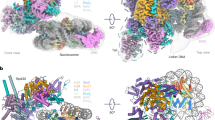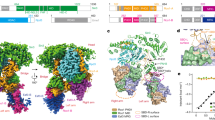Abstract
The dynamic assembly and remodelling of eukaryotic chromosomes facilitate fundamental cellular processes such as DNA replication and gene transcription. The repeating unit of eukaryotic chromosomes is the nucleosome core, consisting of DNA wound about a defined octamer of histone proteins1. Two enzymatic processes that regulate transcription by targeting elements of the nucleosome include ATP-dependent nucleosome remodelling and reversible histone acetylation2,3. The histone deacetylases, however, are unable to deacetylate oligonucleosomal histones in vitro4. The protein complexes that mediate ATP-dependent nucleosome remodelling and histone acetylation/deacetylation in the regulation of transcription were considered to be different, although it has recently been suggested that these activities might be coupled5. We report here the identification and functional characterization of a novel ATP-dependent nucleosome remodelling activity that is part of an endogenous human histone deacetylase complex. This activity is derived from the CHD3 and CHD4 proteins which contain helicase/ATPase domains found in SWI2-related chromatin remodelling factors, and facilitates the deacetylation of oligonucleosomal histones in vitro. We refer to this complex as the nucleosome remodelling and deacetylating (NRD) complex. Our results establish a physical and functional link between the distinct chromatin-modifying activities of histone deacetylases and nucleosome remodelling proteins.





Similar content being viewed by others
References
Elgin, S. C. R. Chromatin Structure and Gene Expression (eds Hames, B. D. & Glover, D. M.) (IRL, Oxford, 1995).
Pazin, M. J. & Kadonaga, J. T. SWI2/SNF2 and related proteins: ATP-driven motors that disrupt protein–DNA interactions? Cell 88, 737–740 (1997).
Imhof, A. & Wolffe, A. P. Transcription: gene control by targeted histone acetylation. Curr. Biol. 8, R422–424 (1998).
Hassig, C. A. et al. Arole for histone deacetylase activity in HDAC1-mediated transcriptional repression. Proc. Natl Acad. Sci. USA 95, 3519–3524 (1998).
Wade, P. A., Jones, P. L., Vermaak, D. & Wolffe, A. P. Amultiple subunit Mi-2 histone deacetylase from Xenopus laevis cofractionates with an associated Snf2 superfamily ATPase. Curr. Biol. 8, 843–846 (1998).
Tavladoraki, P. et al. Maize polyamine oxidase—primary structure from protein and cDNA sequencing. FEBS Lett. 426, 62–66 (1998).
Seelig, H. P. et al. The major dermatomyositis-specific Mi-2 autoantigen is a presumed helicase involved in transcriptional activation. Arthr. Rheum. 38, 1389–1399 (1995).
Ge, Q., Nilasena, D. S., O'Brien, C. A., Frank, M. B. & Targoff, I. N. Molecular analysis of a major antigenic region of the 240-kD protein of Mi-2 autoantigen. J. Clin. Invest. 96, 1730–1737 (1995).
Woodage, T., Basrai, M. A., Baxevanis, A. D., Hieter, P. & Collins, F. S. Characterization of the CHD family of proteins. Proc. Natl Acad. Sci. USA 94, 11472–11477 (1997).
Hartzog, G. A. & Winston, F. Nucleosomes and transcription: recent lessons from genetics. Curr. Opin. Genet. Dev. 7, 192–198 (1997).
Kadonaga, J. T. Eukaryotic transcription: an interlaced network of transcription factors and chromatin-modifying machines. Cell 92, 307–313 (1998).
De Rubertis, F. et al. The histone deacetylase RPD3 counteracts genomic silencing in Drosophila and yeast. Nature 384, 589–591 (1996).
Schnitzler, G., Sif, S. & Kingston, R. E. Human SWI/SNF interconverts a nucleosome between its base state and a stable remodeled state. Cell 94, 17–27 (1998).
Cote, J., Utley, R. T. & Workman, J. L. Basic analysis of transcription factor binding to nucleosomes. Meth. Mol. Genet. 6, 108–128 (1995).
Acknowledgements
We thank W. Wang for unpublished CHD3 and CHD4 antisera and for sharing unpublished results; I. Targoff for human Mi-2-positive antiserum and rabbit anti-Mi-2α antiserum; W.Lane and colleagues at the Harvard Microsequencing Facility for peptide microsequencing; O. Rando, C. Grozinger, D. Ayer, and I. Wilson for discussion; and the NIH Cell Culture Center for technical assistance. This work was supported by a National Institute of General Medical Sciences grant to S.L.S. and an NIH grant to R.E.K. G.R.S. is a Helen Hay Whitney Fellow. Predoctoral fellowships from the NSF and the Harvard-Markey Biomedical Scientist Program to J.K.T. and an NIH predoctoral training grant to C.A.H. are gratefully acknowledged. S.L.S. is an Investigator of the Howard Hughes Medical Institute.
Author information
Authors and Affiliations
Corresponding author
Rights and permissions
About this article
Cite this article
Tong, J., Hassig, C., Schnitzler, G. et al. Chromatin deacetylation by an ATP-dependent nucleosome remodelling complex. Nature 395, 917–921 (1998). https://doi.org/10.1038/27699
Received:
Accepted:
Issue Date:
DOI: https://doi.org/10.1038/27699
- Springer Nature Limited
This article is cited by
-
The epigenetic factor CHD4 contributes to metastasis by regulating the EZH2/β-catenin axis and acts as a therapeutic target in ovarian cancer
Journal of Translational Medicine (2023)
-
HDAC1/2/3 are major histone desuccinylases critical for promoter desuccinylation
Cell Discovery (2023)
-
Live-cell three-dimensional single-molecule tracking reveals modulation of enhancer dynamics by NuRD
Nature Structural & Molecular Biology (2023)
-
ARID1A-dependent maintenance of H3.3 is required for repressive CHD4-ZMYND8 chromatin interactions at super-enhancers
BMC Biology (2022)
-
Importance of clitellar tissue in the regeneration ability of earthworm Eudrilus eugeniae
Functional & Integrative Genomics (2022)





